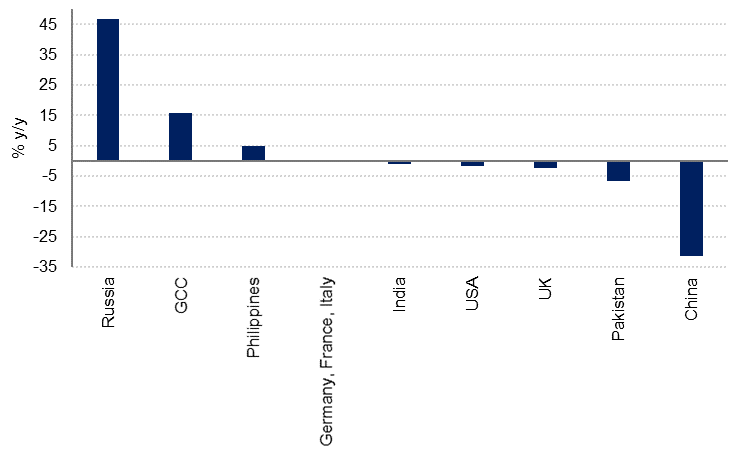
After a strong January, the number of visitors to Dubai in February 2020 declined -3.3% y/y as travel restrictions to contain the spread of COVID-19 started to be imposed. This was most evident in the -72% y/y drop in the number of Chinese visitors to Dubai in February. China was the first country to limit the movement of people and by February, several countries had already started restricting flights to and from the country with the UAE cancelling all China flights except Beijing from 3 February.
Kuwait, Iran and Nigeria also saw a double-digit decline in visitor numbers to Dubai in February. However, this was offset by nearly 50% growth in the number of Russians visiting Dubai, as well as solid growth in visitors from Australia and the Philippines.
Looking at the cumulative data for the first two months, India has returned to the top spot in terms of the biggest source of visitors to Dubai, although the number of visitors was slightly lower than in Jan-Feb 2019. Saudi Arabia was back in second place, with visitor numbers up by more than one-third on the first two months of last year. UK and Eurozone visitor numbers were largely unchanged y/y. The strongest growth was from Russia, with visitors up 47% y/y in Jan-Feb 2020. Chinese visitor numbers shrank by a third compared to the same period last year.
 Source: Dubai Tourism, Emirates NBD Research
Source: Dubai Tourism, Emirates NBD Research
The number of hotel rooms in Dubai increased 0.2% m/m and 8.8% y/y in February 2020. Dubai Tourism data show occupancy rates averaged 82% ytd, lower than the 84% recorded in Jan-Feb 2019. However, it appears that hotels and hotel apartments offered incentives in order to support demand, with the revenue per available room (RevPAR) declining -10.6% y/y in Jan-Feb 2020.
We expect visitor numbers to contract sharply in March as almost all passenger traffic into and out of the UAE was halted and is unlikely to resume for several more weeks. Indeed the Dubai PMI survey data showed a steep contraction in new work and output in the travel and tourism sector in March.